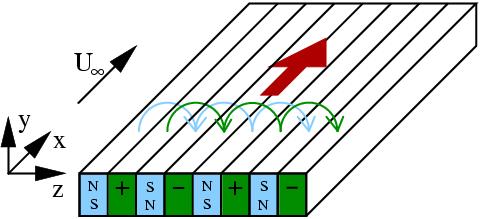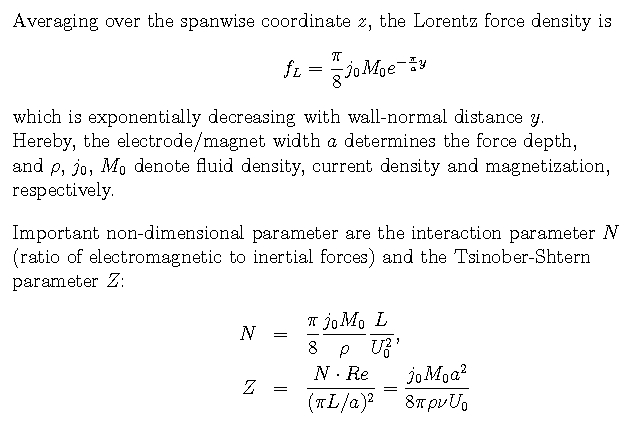Gerd Mutschke
Electromagnetic Boundary Layer Control
In weakly conducting fluids (e.g. seawater), externally applied
electric and magnetic fields can achieve significant control of the
near-wall flow. Below, a typical strip-like actuator for creating
a wall-parallel Lorentz force is shown. The force amplitude
decreases exponentially with wall-normal distance.

Sketch of the control device mounted flush on the surface of the body.
Lorentz force and characteristic parameter

Boundary Layer
Lorentz forcing could be used to influence transition.
Forcing with Z=1 asymptotically leads to an exponential velocity profile
which is more stable than the Blasius profile.
Some results on
boundary layer flow control
by steady streamwise forcing can be found in
E. Kneisel - Kleiner Beleg, TU Dresden, 2003
(in German).
Recent results can be found in:
T.Albrecht, R.Grundmann, G.Mutschke, G.Gerbeth,
On the stability of the boundary layer subject to a wall-parallel
Lorentz force,
Physics of Fluids 18 (2006) 098103.
Hydrofoils
Lorentz force control could be applied in order to increase lift.
The following figure shows numerical results of steady streamwise Lorentz
force control (separation control) for the
flow around an inclined
symmetric hydrofoil
at at low Reynolds numbers,
obtained by a spectral element code. The actuator is located at the
suction side of the foil.

For recent numerical results on steady control as well as on
oscillatory control, please check:
G.Mutschke et al., Separation control at hydrofoils using Lorentz
forces, European Journal of Mechanics B/Fluids 25 (2006) 137-152.
For more experimentally-oriented results, please have a look
at
Tom's EBLC pages
.
Last update: Sept. 18, 2006 Gerd Mutschke


